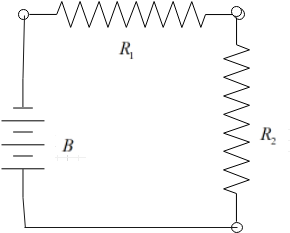
How many branches can a series circuit have?
Answer
519.6k+ views
Hint: We know that there are two types of circuit combination, namely the series and parallel. Accordingly, the load or the resistance offered on the circuit varies. To understand the branching in the series, let us look at the characteristics of the series and parallel circuit.
Complete answer:
We know that an electrical circuit is a closed loop through which electrical current or the charged electrons flow through. It is made up of many electrical components, the most basic or simple electrical circuit, contains the following components, the source or battery, connecting wires, load or resistance and switch.
Now, the load or resistance can either be connected in series or parallel with respect to the source, and hence the total or the net resistance offered by the circuit, varies.
When two or more resistances are connected in series, the total resistance offered by the circuit is the sum of the individual resistances, which is greater than the individual resistance connected in the circuit. Here, the current through all the resistances remains a contestant, as the potential drop across each resistance varies.
A series circuit, looks like the following below:

Similarly, when two or more resistances are connected in parallel, the total resistance offered by the circuit is summing of reciprocal the individual resistances, which is lesser than the individual resistance connected in the circuit. Here, the potential drop or voltage across all the resistances remains a contestant, as the current through each resistance varies.
A parallel circuit, looks like the following below:

Clearly, from the figure shown above on comparing, we see that parallel circuits have branching of wires, but there is no branching seen in series circuits.
Hence we can conclude that there is no branching seen in series circuits.
Note:
We know from Ohm’s law, that the potential drop across any two points is proportional to the current to the flowing through the points. We can also say that two or more resistance are said to be in series, if they have only one common point between them, and similarly two or more resistance are said to be in series, if they have two or more common points between them.
Complete answer:
We know that an electrical circuit is a closed loop through which electrical current or the charged electrons flow through. It is made up of many electrical components, the most basic or simple electrical circuit, contains the following components, the source or battery, connecting wires, load or resistance and switch.
Now, the load or resistance can either be connected in series or parallel with respect to the source, and hence the total or the net resistance offered by the circuit, varies.
When two or more resistances are connected in series, the total resistance offered by the circuit is the sum of the individual resistances, which is greater than the individual resistance connected in the circuit. Here, the current through all the resistances remains a contestant, as the potential drop across each resistance varies.
A series circuit, looks like the following below:

Similarly, when two or more resistances are connected in parallel, the total resistance offered by the circuit is summing of reciprocal the individual resistances, which is lesser than the individual resistance connected in the circuit. Here, the potential drop or voltage across all the resistances remains a contestant, as the current through each resistance varies.
A parallel circuit, looks like the following below:

Clearly, from the figure shown above on comparing, we see that parallel circuits have branching of wires, but there is no branching seen in series circuits.
Hence we can conclude that there is no branching seen in series circuits.
Note:
We know from Ohm’s law, that the potential drop across any two points is proportional to the current to the flowing through the points. We can also say that two or more resistance are said to be in series, if they have only one common point between them, and similarly two or more resistance are said to be in series, if they have two or more common points between them.
Recently Updated Pages
Why are manures considered better than fertilizers class 11 biology CBSE

Find the coordinates of the midpoint of the line segment class 11 maths CBSE

Distinguish between static friction limiting friction class 11 physics CBSE

The Chairman of the constituent Assembly was A Jawaharlal class 11 social science CBSE

The first National Commission on Labour NCL submitted class 11 social science CBSE

Number of all subshell of n + l 7 is A 4 B 5 C 6 D class 11 chemistry CBSE

Trending doubts
What is meant by exothermic and endothermic reactions class 11 chemistry CBSE

10 examples of friction in our daily life

One Metric ton is equal to kg A 10000 B 1000 C 100 class 11 physics CBSE

1 Quintal is equal to a 110 kg b 10 kg c 100kg d 1000 class 11 physics CBSE

Difference Between Prokaryotic Cells and Eukaryotic Cells

What are Quantum numbers Explain the quantum number class 11 chemistry CBSE




